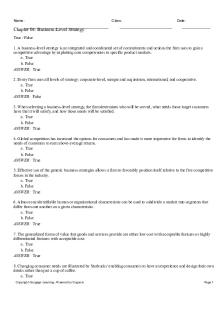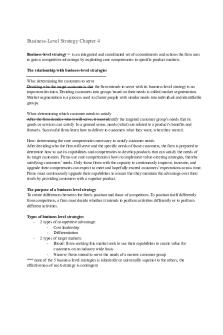Chapter 6 - Corporate-Level Strategy PDF

| Title | Chapter 6 - Corporate-Level Strategy |
|---|---|
| Course | Strategy and Competition |
| Institution | Concordia University |
| Pages | 10 |
| File Size | 270.5 KB |
| File Type | |
| Total Downloads | 97 |
| Total Views | 144 |
Summary
Download Chapter 6 - Corporate-Level Strategy PDF
Description
Chapter 6: Corporate-level strategy Corporate-level strategies, which are strategies use to diversify their operations from a single business competing in a single market into several product markets – most commonly, into several businesses Corporate-level strategies specify actions a firm takes to gain a competitive advantage by selecting and managing a group of different businesses competing in different product markets It helps companies to select new strategic positions – positions that are expected to increase the firm’s value Firms use corporate-level strategies as a means to grow revenues and profits, pursue defensive or offensive strategies, pursue market development by entering different geographic markets, acquire competitors (horizontal integration) and/or buy suppliers/customers (vertical integration) The basic corporate strategy focuses on diversification Effective firms carefully evaluate their growth options before committing firm resources to any of them bc it is not a risk-free choice Bc the diversified firm operates in several different and unique product markets and likely in several businesses, it forms 2 types of strategies: corporate-level and business-level. Corporate-level has 2 concerns: -
In what product markets and businesses the firm should compete How corporate headquarters should manage those businesses
For the diversified company, a business-level strategy must be selected for each of the businesses in which the firm has decided to compete An effective corporate-level strategy creates, across all of a firm’s businesses, aggregate returns that exceed what those returns would be without the strategy and contributes to the firm’s strategic competitiveness and its ability to earn above-avg returns Product diversification, a primary form of corporate-level strategies, concerns the scope of the markets and industries in which the firm competes as well as “how managers buy, create, and sell different businesses to match skills and strengths with opp presented to the firm Successful diversification is expected to reduce variability in the firm’s profitability, provide firms with the flexibility to shift their investments, the ideal portfolio of businesses balances diversification’s costs and benefits
Levels of diversification 5 categories of businesses according to increasing diversification levels of diversification. The single and dominant business categories denote no or relatively low levels of diversification; more fully diversified firms are classified into related and unrelated categories. A firm is related through its diversification when its businesses share several links (product markets, technologies, or distribution channels) The more links among the businesses, the more constrained is the level of diversification “Unrelated” refers to absence of direct links between businesses Low levels of diversification Firms that focus on one or very few businesses and markets and can earn positive returns, bc they develop capabilities useful for these markets and can provide superior service to customers. Additionally, there are fewer challenges in managing one or very small set of businesses, allowing them to gain economies of scale and efficiently use their resources Single business A single-business diversification strategy is a corporate-level strategy wherein the firm generates 95 percent or more of its sales revenue from its core business area Dominant business The firm generates between 70 and 95 percent of its total revenue within a single business area Moderate and high levels of diversification Related constrained A firm generating more than 30 percent of its revenue outside a dominant business and whose business are related to each other in some manner uses a related diversification corporate-level strategy. When the links between diversified firm’s businesses are rather direct – meaning they use similar sourcing, throughput, and outbound processes- it is a related constrained diversification strategy. Related linked (mixed related and unrelated) The diversified company with a portfolio of businesses that have only a few links between them is called a mixed related and unrelated firm and is using the related linked diversification strategy Related linked firms share fewer resources and assets between their businesses, concentrating instead on transferring knowledge and core competencies between them Very high levels of diversification Unrelated
A highly diversified firm that has no relationships between its businesses follows and unrelated diversification strategy Firms using this strategy are called conglomerates Independently run with decentralized operating divisions
Reasons for diversification A diversification strategy is used to increase the firm’s value by improving its overall performance. Value is created – either through related diversification or through overall performance – when the strategy allows a company’s businesses to increase revenues or reduce costs while implementing their business-level strategies
Value-neutral reasons for diversification include a desire to match and thereby neutralize a competitor’s market power Decisions to expand a firm’s portfolio of businesses to reduce managerial risk or increase top manager’s pay can have a negative effect o the firm’s value Greater amounts of diversification reduce managerial risk in that if one of the businesses in a diversified portfolio fails, the top executive of that business does not risk total failure by the corporation reduces top executives’ employment risk Bc diversification increase a firm’s size and thus managerial compensation, managers have motives to diversify a firm to a level that reduces its value Operational relatedness and corporate relatedness are 2 diversification strategies that can create value
-
Shows the importance of resources and key competencies
The vertical dimension depicts opportunities to share operational activities between businesses (operational relatedness), while the horizontal dimension suggests opportunities for transferring corporate-level core competencies (corporate relatedness). The firm with a strong capability in managing operational synergy, especially in sharing assets between its businesses, falls in the upper left quadrant, which also represents vertical sharing of assets through vertical integration. The lower right quadrant represents a highly developed corporate capability for transferring one or more core competencies across businesses
Value-creating diversification: related constrained and related linked diversification With the related diversification corporate-level strategy, the firm builds upon or extends its resources and capabilities to build a competitive advantage by creating value for customers. The company using the related diversification strategy wants to develop and exploit economies of scope between its businesses Economies of scope are costs savings a firm creates by successfully sharing resources and capabilities or transferring one or more corporate-level core competencies that were developed in one of its businesses to another of its businesses Firms seek to create value from economies of scope through 2 basic kinds of operational economies: sharing activities (operational relatedness) and transferring corporate-level core competencies (corporate relatedness) Difference between sharing activities (tangible) and transferring core competencies (intangible) is based on how separate resources are jointly used to create economies of scope
Operational relatedness: Sharing activities Firms can create operational relatedness by sharing either a primary activity or a support activity Activity sharing is also risky bc ties among a firm’s businesses create links between outcomes -
If demand for one business’ product is reduced, it may not generate sufficient revenues to cover fixed costs required to operate the shared facilities
Activity sharing requires careful coordination between the businesses involved After acquisitions see post-acquisition increases in performance and higher returns Gaining economies of scope by sharing activities across a firm’s businesses may be important in reducing risk and in creating value. Corporate relatedness: Transferring of core competencies Corporate-level core competencies are complex sets of resources and capabilities that link different businesses, primarily through managerial and technological knowledge, experience and expertise First, bc the expense of developing core competencies has already been incurred in one of the firm’s businesses, transferring this competence to a second business eliminates the need for that business to allocate resources to develop it Second, resource intangibility difficult for competitor to imitate and to understand One way managers facilitate the transfer of corporate-level competencies is by moving key people into new managerial positions. However, manager of an older business may be reluctant to transfer key ppl who have accumulated knowledge and experience critical to the business’ success Market Power Market power exists when a firm is able to sell its products above the existing competitive level or to reduce the costs of its primary and support activities below the competitive level, or both In addition to efforts to gain scale as a means of increasing market power, firms can foster increased market power through multipoint competition and vertical integration Multipoint competition exists between 2 or more diversified firms simultaneously compete in the same product areas or geographical markets Through multi-point competition, rival firms often experience pressure to diversify bc other firms in their dominant industry segment have made acquisitions to compete in a different market segment
Vertical integration exists when a company produces its own inputs or owns its own source of output distribution Market power is gained as the firm develops its ability to save on its operations, avoid sourcing and market costs, improve product quality, possibly protect its technology from imitation by rivals, and potentially exploit underlying capabilities in the marketplace Better able to improve product quality and improve or create new technologies than specialized firms bc they have access to more info and knowledge that are complementary When firms have strong ties between their productive assets for which no market process exists market power also created Limitations -
Outside suppliers may produce at lower price internal transactions expensive and reduce profitability compared to competitors Bureaucratic costs Reduce substantial investments in specific technologies, it may reduce the firm’s flexibility, especially when techno changes quickly Changes in demand creates capacity balance and coordination problem
Simultaneous operational relatedness and corporate relatedness Difficult for competitors to understand and learn how to imitate If the cost of realizing both types of relatedness is not offset by the benefits created, the result is diseconomies bc the cost of org and incentive structure is very expensive
Unrelated Diversification An unrelated diversification strategy can create value through 2 types of financial economies Financial economies are cost savings realized through improved allocations of financial resources based on investments inside or outside the firm Efficient internal capital allocations can lead to financial economies. Efficient internal capital allocations reduce the risk among the firm’s businesses The restructuring of acquired assets to operate more profitably, and then sells the company for a profit in the external market Efficient Internal Capital Market Allocation Efficiency results as investors take equity positions with high expected cash-flow values Capital is also allocated through debt as shareholders and debt holders try to improve the value of their investments by taking stakes in businesses with high growth and profitability prospects In large diversified firms, the corporate headquarters office distributes capital to its businesses to create value for the overall corporation
The nature of these distributions can generate gains from internal capital market allocations that exceed the gains that would accrue to shareholders as a result of capital being allocated by the external capital market Bc those in a firm’s corporate headquarters generally have access to detailed and accurate info regarding the actual and potential future performance of the company’s portfolio of businesses, they have the nest info to make capital distribution decisions External investors have relatively limited access to internal info and can only estimate the performances of individual businesses as well as their future prospects Although businesses seeking capital must provide info to potential suppliers, firms with internal capital markets can have at least 2 informational advantages -
-
Info provided to capital markets through annual reports and other sources emphasizes positive prospects and outcomes external sources has limited ability to understand operational dynamics Ability to allocate efficiently capital through an internal capital market helps the firm protect the competitive adv it develops (internal allocation don’t need to share info with potential investors competitors don’t have access to the info)
If intervention from outside the firm is required to make corrections to capital allocations, only significant changes are possible bx the power to make changes by outsiders is often indirect -
Forcing bankruptcy Changing top management
Limitation: -
Competitor can imitate more easily financial economies
Restructuring of Assets Financial economies can also be created when firms learn how to create value by buying, restructuring, and then selling the restructured companies’ assets in the external market High technology and service businesses are often human-resource dependent difficult to restructure intangible assets such as human capital and effective relationships that have evolved over time with buyers and sellers Bc of the increase in global economic activity, including more cross-border acquisitions, there is also a growing number of foreign divestitures and restructuring in internal markets Foreign divestitures are even more complex than domestic ones and must be managed carefully
Value-neutral diversification: Incentives and Resources Incentives to Diversity External incentives includes antitrust regulations and tax laws.
Internal incentives include low performance, uncertain future cash flows, the pursuit of synergy, and reduction of risk for the firm. Antitrust regulation and tax laws Antitrust laws prohibiting mergers that created increased market power were stringently enforced during 1960s and 70s. discouraged vertical and horizontal integrations encourage conglomerate 1980s lessened enforcement of antitrust laws increase in vertical and horizontal mergers The tax effects of diversification stem not only from corporate tax changes, but also from individual tax rates While individual tax rates for capital gains and dividend created a shareholder incentive to increase diversification before 1986, they encouraged lower diversification after 1986, unless diversification was funded by tac-deductible debt Increased depreciation produces lower taxable income, thereby providing an additional incentive for acquisitions Low performance If high performance eliminates the need for greater diversification, then low performance may provide an incentive for diversification There are risks to moving into areas that are new and where the company lacks operational expertise. There can be negative synergy and problems between leaders and cultural fit difficulties with recent acquisitions Although low performance can be an incentive to diversify, firms that are more broadly diversified compared to their competitors may have overall lower performance Uncertain future cash flows As a firm’s line matures or is threatened, diversification may be an important defensive strategy. During a financial downturn, diversification improves performance bc external capital markets are costly and internal resource allocation bc more important Diversifying into other product markets or into other businesses can reduce the uncertainty about a firm’s future cash flows Synergy and firm risk reduction Diversified firms pursuing economies of scope often have investments that are too inflexible as they try to realize synergy among business units Synergy produces joint interdependence among businesses that constraints the firm’s flexibility to respond 2 basic decisions
1. The firm may reduce its level of technological change by operating in environments that are more certain Risk adverse uninterested in pursuing new product lines that have potential but are not proven Operating in environment that are more certain will more likely lead to related diversification into industry that lack potential 2. The firm may constraint its level of activity sharing and forgo potential benefits of synergy Constraining level of activity sharing may produce additional , but unrelated, diversification where the firm lack expertise Resources and diversification Even when incentives to diversify exist, a firm must have the types and levels of resources and capabilities needed to successfully use a corporate-level diversification strategy Indeed, the degree to which resources are valuable, rare, difficult to imitate and nonsubstituable influence a firm’s ability to create value through diversification Any excess capacity often can be used only for closely related products, especially those requiring highly similar manufacturing technologies Excess capacity of other tangible resources, such as sales force, can be used to diversify more easily. Again, excess capacity in a sales force is more effective with related diversification bc it may be utilized to sell products in similar markets Sales forces knowledgeable about related product characteristics, customers and distribution channels Intangible resources are more flexible than tangible physical assets in facilitating diversification
Value-reducing diversification: managerial motives to diversify The desire for increased compensation and reduced managerial risk are 2 motives for toplevel executives to diversify their firm beyond value-creating and value-neutral levels Diversification and firm size are highly correlated and so does executive compensation and social status Governance mechanism may limit managerial tendencies to over diversify If governance mechanism are not strong enough and executives diversify at a point that it fails to earn above avg returns -
The loss of adequate internal governance may results in relatively low performance, triggering a threat of takeover
Top-level executives’ diversification decisions may also be held in check by concerns for their reputation. If a positive reputation decision facilitates development and use of managerial power, a poor reputation can reduce it. Likewise, a strong external market for managerial talent may deter managers from pursuing inappropriate diversification Knowing that their firms could be acquired if they are not managed successfully encourages executive to use value-creating diversification strategies The greater the incentives and the more flexible the resources, the higher level of expected diversification. Financial resources should have a stronger relationship to the extend of diversification than either tangible or intangible resources...
Similar Free PDFs

Chapter 6 - Corporate-Level Strategy
- 10 Pages

Blue Ocean Strategy 1 Chapter 6
- 27 Pages

Chapter 09 Cooperative Strategy
- 24 Pages

CH 6 - Corporate Level Strategy
- 9 Pages

Chapter 7 Process Strategy
- 3 Pages

Chapter 10 Strategy Excecution
- 38 Pages

Chapter 08 International Strategy
- 24 Pages

TB-Chapter 4-Strategy
- 67 Pages

Chapter 3 Operations Strategy
- 8 Pages

Chapter 8 - Hedge strategy
- 20 Pages

Chapter 04 Business Level Strategy
- 21 Pages

Chapter 04 Business Level Strategy
- 25 Pages
Popular Institutions
- Tinajero National High School - Annex
- Politeknik Caltex Riau
- Yokohama City University
- SGT University
- University of Al-Qadisiyah
- Divine Word College of Vigan
- Techniek College Rotterdam
- Universidade de Santiago
- Universiti Teknologi MARA Cawangan Johor Kampus Pasir Gudang
- Poltekkes Kemenkes Yogyakarta
- Baguio City National High School
- Colegio san marcos
- preparatoria uno
- Centro de Bachillerato Tecnológico Industrial y de Servicios No. 107
- Dalian Maritime University
- Quang Trung Secondary School
- Colegio Tecnológico en Informática
- Corporación Regional de Educación Superior
- Grupo CEDVA
- Dar Al Uloom University
- Centro de Estudios Preuniversitarios de la Universidad Nacional de Ingeniería
- 上智大学
- Aakash International School, Nuna Majara
- San Felipe Neri Catholic School
- Kang Chiao International School - New Taipei City
- Misamis Occidental National High School
- Institución Educativa Escuela Normal Juan Ladrilleros
- Kolehiyo ng Pantukan
- Batanes State College
- Instituto Continental
- Sekolah Menengah Kejuruan Kesehatan Kaltara (Tarakan)
- Colegio de La Inmaculada Concepcion - Cebu



